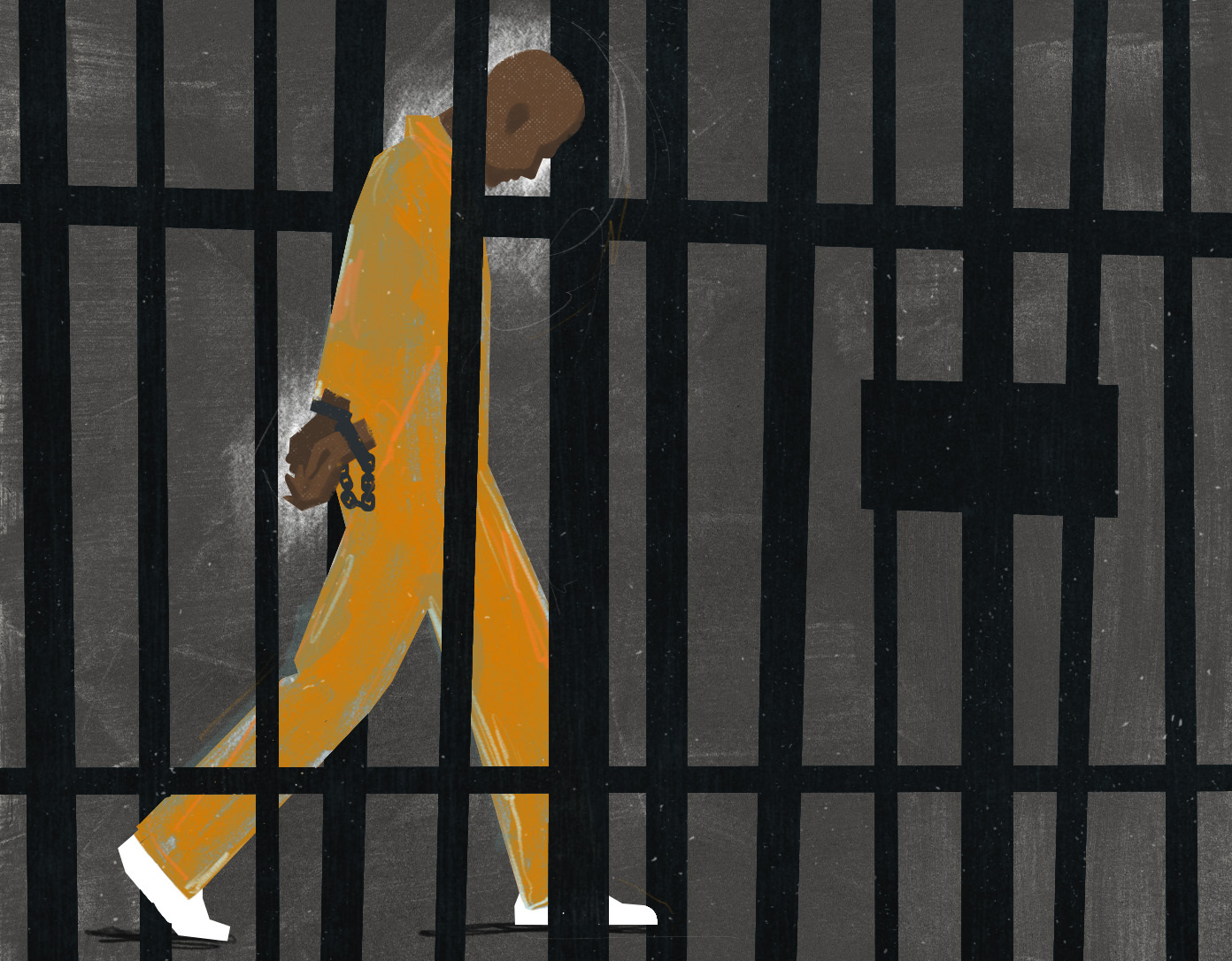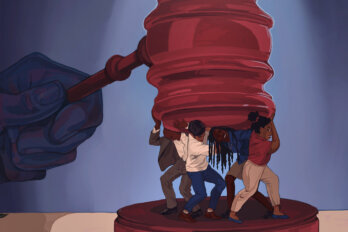In 2002, a group of men pushed their way into a Scarborough nightclub without paying cover. They scuffled with Colin and Roger Moore, two brothers who were hosting a monthly fundraising event. Words were exchanged, punches were thrown, bottles broken, a glass door smashed. The group eventually left. Minutes later, two gunmen burst into the kitchen and opened fire on the brothers. Colin would die of his injuries. Police arrested one of the gunmen a short time later, and a search for the getaway vehicle led them to Leighton Hay, who, they decided, was the second shooter. Hay was charged with both first-degree and attempted murder.
Crown prosecutors hung a significant amount of their evidence on eyewitness accounts of the second shooter—but the case was remarkably weak. One witness picked Hay out of a photo lineup but, according to court documents, confessed that Hay resembled the shooter only about “80 percent.” The prosecution put them on the stand at trial anyway. Eyewitnesses also agreed that the shooter had short dreadlocks. But Hay had a buzz cut. Prosecutors argued that Hay had buzzed his hair to cover up his crime, presenting clippings obtained from his razor as proof.
Hay’s defence was strong: his sister, who was dating the first gunman, testified Hay was asleep when they returned home. Despite all that, he was convicted. And his conviction was upheld on appeal.
The prosecutors fought to prevent the forensic testing of Hay’s hair—and for good reason, as the testing showed that the hairs were most likely facial and not from his head. The exculpatory evidence led the Supreme Court to unanimously declare that Hay deserved a new trial. Prosecutors withdrew the charge. Hay was released in 2014, after serving twelve years in prison. The case made national news.
Hay’s story, however, is emblematic of something deeper: Canada’s justice system has a habit of putting people behind bars for crimes they did not commit. We know about the high-profile cases, like that of Hay, but many fly under the radar of media coverage. It’s no surprise that some of the strongest advocates of judicial reform have been the wrongfully convicted themselves.
David Milgaard spent twenty-three years in prison for a rape and murder he did not commit. Even though his conviction was quashed in 1992, he was not formally exonerated until 1997—when he received an official apology from the Saskatchewan government. Two years later, he received $10 million in compensation for his time in jail. In recent years, he became a champion for Odelia and Nerissa Quewezance. The sisters, from the Keeseekoose First Nation in Saskatchewan, were convicted in 1994 of the murder of Anthony Dolff a year earlier—despite their cousin confessing to the crime. Thanks, in part, to Milgaard’s championing of their case, bail hearings for the sisters are expected in the fall. It could take years before they are officially exonerated. Unfortunately, Milgaard, who died earlier this year, will never see them walk free.
Over the past several decades, seven public inquiries have looked into the trend of wrongful convictions. In 2019, a working group of Crown prosecutors from the provinces and territories as well as the federal prosecution service published a damning report. “We have known for decades that factually innocent people in Canada have been convicted of crimes they did not commit,” it begins. Because issues at the root of the problem are “systemic, broad and interconnected,” individual prosecutors or cops can’t hope to completely fix it. People languish in prison because of eyewitness errors, false confessions, jailhouse informants, or faulty forensics. But a flawed justice system putting innocent people in jail is only one part of the problem. The other is that overturning those mistaken convictions is near impossible. Those incarcerated who believe their cases haven’t been judged fairly often lack resources and support while facing massive bureaucratic hurdles. The last reprieve for the wrongfully convicted is submitting a petition to the Department of Justice, asking it to intervene—a petition that can often lie on a desk for years.
After Justin Trudeau won his reelection bid in 2019, he instructed justice minister David Lametti to “make it easier and faster for potentially wrongfully convicted people to have their applications reviewed.” Almost three years on, all the Trudeau government has managed to do is produce its own report—this one, released in 2021, was prepared by Harry LaForme, the first Indigenous judge of an appeals court in Canada, and Juanita Westmoreland-Traoré, the first Black judge appointed to a Quebec court.
They spoke to over 200 people: exonerees, crime victims, police officers, prosecutors, defence lawyers, legal aid officials, judges, and forensic scientists. “It is impossible to know how many undiscovered, and thus uncorrected, miscarriages of justice exist,” noted LaForme and Westmoreland-Traoré. “But we are confident that there are many and that Indigenous, Black and other disadvantaged groups are overrepresented among the wrongfully convicted.” Their report provides the most compelling language yet on the “devastating and life-altering harms” of wrongful guilty verdicts and on the dire need for an independent commission that can reassess those convictions.
Lametti is expected to table legislation to create such a commission (he told the Canadian Press in May that he could not give an “absolute timeline” as to when). But the government’s reform plans have refocused attention on a justice system that is woefully broken—a system where exonerating the innocent is incredibly difficult and becoming more so.
“Except for the very informed, most of society has a TV view of our justice system and the way that it works,” says Lisa Johnson, a criminal lawyer, adjunct professor, and director of the Osgoode Hall Law School Innocence Project, a program in which enrolled students review claims of wrongful conviction. People tend to believe, she says, that good always wins out—that courts always find the truth and that innocent people don’t go to jail. That’s wrong.
Start with the cost of a lawyer: for a criminal trial, it can begin around $5,000 and can easily exceed $50,000—that’s before add-ons, such as expert witnesses. If you can’t afford the fees, there’s legal aid. For a one-person household, Ontario and Alberta limit access to those who, on average, make less than $20,000 per year. In certain provinces, defendants whose incomes take them outside the qualifying criteria might even be required to pay back some of their legal aid. “So if you make $40,000, $50,000, $60,000—you can’t afford a lawyer, but you can’t get legal aid,” Johnson says. That financial burden leads many to simply plead guilty, with some cutting a deal to serve less time.
If you fight your case and lose, she adds, “You do have a right to appeal.” But it’s rarely that easy. If you are convicted of a criminal offence in Ontario, for example, you can contest the conviction at the Superior Court of Justice. If you lose there, the next stop is the Court of Appeal. But here’s where the process gets especially tricky. If you make it to the Court of Appeal, there is little guarantee of a full relitigation of your case: such courts generally look for errors in law made at trial or for new evidence that wasn’t heard. Pleading that the jury merely came to the wrong decision is not enough. According to a 2013 report by the Ontario Court of Appeal, only 32 percent of criminal appeals were ever successful. It’s true that, if you lose your case there, you can petition to go to the Supreme Court. But the test for bringing the case to the Supreme Court is stringent: judges generally hear only cases of national significance.
There is a final avenue for clemency. The Criminal Conviction Review Group is an office in Ottawa belonging to the Department of Justice. The CCRG is tasked with delving into problematic criminal cases and, where merited, referring them to the minister of justice for possible retrial. But there’s a catch, Johnson explains: “You have to have exhausted your appeals, up to and including the Court of Appeal. If you haven’t done that, you can’t get to the minister of justice to review your wrongful conviction.” It is, in other words, a door open only to those who have spent years and, likely, tens of thousands of dollars, at least, fighting their case—even if there is little chance of winning.
But there’s no guarantee any of that will happen. Because, after you have exhausted your financial reserves on your trial, an appeal tends to become impossibly expensive. Johnson had a client who lost his case at the Ontario Court of Justice despite troubling aspects in the police investigation, which included an allegedly illegal search. “I believe an appeal could have been successful,” she says, “but this client could not get Legal Aid Ontario to pay for an appeal, and he could not afford it himself, so he had to forgo it.”
Of course, you can always act on your own behalf. But that path is filled with pitfalls. If you remain in custody awaiting trial, as many facing homicide charges do, you have no access to the internet, and legal textbooks are often out of date. During COVID-19, lockdowns made prison libraries difficult to use.
Information on this legal practice is hard to come by, but one study, prepared by data company Loom Analytics in 2016, found that people who represented themselves won around 12 percent of the motions and applications they put forward in court. In complex criminal trials, particularly, taking your defence into your own hands is an incredibly risky move.
One federal study sought to understand those who represented themselves. It found that self-represented defendants in criminal trials tended to believe “that if they were innocent, they did not need a lawyer.” Self-represented defendants also tended to miss possible Charter arguments available to them.
That’s what happened to Glen Assoun. In 1998, Assoun was arrested for the murder of Brenda Way, his ex-partner. When he went to trial the next year, he fired his lawyer and, unable to get legal aid, was stuck defending himself. He knew he was innocent but was unable to make his case within the tightly regulated rules of a Canadian courtroom. He was convicted and sentenced to life in prison in 1999.
When he sought to appeal his conviction, criminal defence lawyer Jerome Kennedy took up his case. Even though Kennedy revealed the absurd weakness of the prosecution’s evidence—which involved statements from a psychic—the Nova Scotia court dismissed the appeal.
Innocence Canada stepped in. A small nonprofit of pro bono lawyers, it intervenes in cases of the wrongfully convicted. In fact, since 1993, the organization has managed to exonerate over twenty-four people. When it came to Assoun, Innocence Canada submitted a detailed memorandum to the justice minister in 2013, making the compelling argument that Way had been murdered by serial killer Michael McGray. It would take until 2014 for Assoun to be released on bail, after the CCRG concluded he may have been wrongfully convicted. It wasn’t until 2019 that Lametti ordered a new trial. Twenty years after Assoun was convicted, the charges against him were dropped.
Ron Dalton, Innocence Canada’s co-president, knows better than most how agonizingly slow the process can be. When his wife died after choking in their home in Gander, Newfoundland, in 1988, a pathologist decided that it was Dalton who had strangled her. He spent a total of eight years behind bars before he was ultimately acquitted. When he got out, he set about making sure that other innocent people didn’t waste away in prison.
“This ragtag bunch,” he says about his team, “has done some pretty good work.” But it’s tough work too. About half of their 109 cases are on a wait list, “because we can’t handle everything that comes in the door immediately.”
If groups like Innocence Canada do not have the resources to handle their backlog, the CCRG can’t be relied on either. With its small staff, the office can take years to reach a decision on cases. And, as part of the Department of Justice, it has no real independence.
It’s no surprise, therefore, that one recommendation keeps coming up: Canada needs a new independent body that can investigate and help free those who have faced travesties of justice. The report by LaForme and Westmoreland-Traoré, for example, presented the federal government with stark choices. Rather than a commission that reviews individual cases, Ottawa needs one that intervenes preemptively and tackles a system that “has failed to provide remedies for women, Indigenous or Black people in the same proportion as they are represented in Canada’s prisons.” Rather than a commission that is “treated like a small administrative agency in the federal government,” what is needed is one that is well funded and “subject to the same arm’s-length treatment from the government as the judiciary.” Finally, Ottawa can have a commission that tends to favour reviewing cases where factual innocence can be more scientifically established, such as by DNA, or it can devote its resources to all miscarriages of justice. In short, only substantial reform will stop innocent people from being kept behind bars.
When I asked Lametti about the extent of the reforms being planned, he wrote back simply to say that “a well-functioning justice system is one that serves all Canadians, protects the vulnerable, and builds a safer and better Canada.” Advocates who will keep watching the wrongfully convicted shoulder the burden of this broken system have no choice but to wait. “Politics can be very slow moving,” Johnson says.





